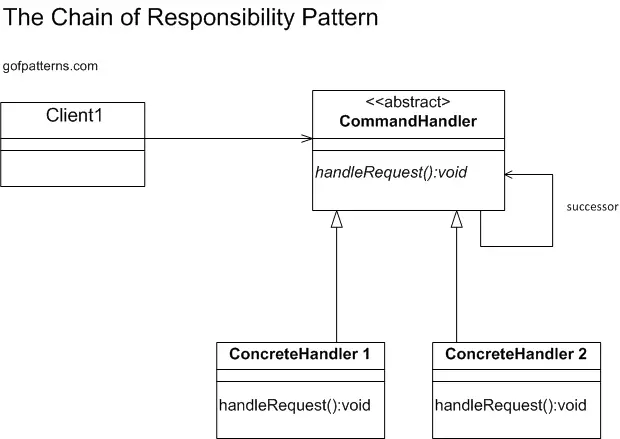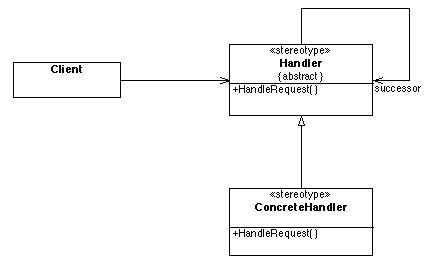Chain of Responsibility Design Pattern
The Chain of Responsibility pattern establishes a chain within a system, so that a message can either be handled at the level where it is first received, or be directed to an object that can handle it.

Benefits of the Chain of Responsibility Design Pattern
Question: What are the benefits of the 'Chain of Responsibility Design Pattern'?
The Chain of Responsibility Design Pattern, a behavioral design pattern, offers several distinct advantages in the realm of software development. This pattern allows an object to send a command down a chain of potential receivers until an object handles it. The central idea is to decouple the sender and receiver of a request based on the type of request.
Here are the primary benefits of the Chain of Responsibility Design Pattern:
However, while the Chain of Responsibility Pattern provides numerous benefits, it's crucial to understand its potential drawbacks. It's not guaranteed that every request will be handled as it can pass down the entire chain without finding a suitable handler. Moreover, it can lead to increased time for request processing due to traversing the entire chain.
Therefore, as with any design pattern, it's essential to consider these factors and use the Chain of Responsibility Pattern when it is most appropriate for the system's requirements and constraints. This pattern is often used in conjunction with others, such as the Command Pattern, to enhance its benefits and mitigate its drawbacks.
The Chain of Responsibility Design Pattern, a behavioral design pattern, offers several distinct advantages in the realm of software development. This pattern allows an object to send a command down a chain of potential receivers until an object handles it. The central idea is to decouple the sender and receiver of a request based on the type of request.
Here are the primary benefits of the Chain of Responsibility Design Pattern:
- Decoupling Sender and Receiver: Similar to the Command Pattern, the Chain of Responsibility Pattern enables the sender of a request to be decoupled from its receiver. The sender doesn't need to know the chain's structure, the request's handler, or how it's handled. This abstraction leads to cleaner, more modular code.
- Dynamic Handling: This pattern allows dynamic runtime handling of a request. The handler isn't fixed and can be decided at runtime based on the chain's structure, increasing flexibility and customization potential.
- Flexibility in Assigning Responsibilities: With the Chain of Responsibility pattern, you can restructure the chain or change its members without affecting the client. This makes it easy to add or remove responsibilities or change their order.
- Sequential Processing: The pattern can enforce a specific order of processing requests by creating a sequence of handlers. This can be useful in situations where the order of operations is crucial.
- Reducing Code Complexity: Instead of having a complex if-else or switch-case construct to handle various types of requests, the pattern allows breaking down this complexity into a set of classes, each handling its responsibility, making the code more manageable and readable.
- Adding New Handlers: You can introduce new handlers into the system without modifying the existing client code, provided they adhere to the same interface as the other handlers. This aligns with the open-closed principle of software design, allowing systems to be open for extension but closed for modification.
However, while the Chain of Responsibility Pattern provides numerous benefits, it's crucial to understand its potential drawbacks. It's not guaranteed that every request will be handled as it can pass down the entire chain without finding a suitable handler. Moreover, it can lead to increased time for request processing due to traversing the entire chain.
Therefore, as with any design pattern, it's essential to consider these factors and use the Chain of Responsibility Pattern when it is most appropriate for the system's requirements and constraints. This pattern is often used in conjunction with others, such as the Command Pattern, to enhance its benefits and mitigate its drawbacks.
The following lists the benefits of using the Chain of Responsibility pattern:
- Reduced coupling
- Added flexibility in assigning responsibilites to objects
- Allows a set of classes to behave as a whole, because events produced in one class can be sent on to other handler classes within the composite.
When To Use the Chain of Responsibility Design Pattern
You should use the Chain of Responsibility Pattern when:
- More than one object can handle a request, and the handler is not known.
- You want to issue a request to one of several objects without specifying the receiver completely.
- The set of objects that can handle a request should be specified dynamically.
In Object Oriented Design, the chain-of-responsibility pattern is a design pattern consisting of a source of command objects and a series of processing objects. Each processing object contains logic that defines the types of command objects that it can handle; the rest are passed to the next processing object in the chain. A mechanism also exists for adding new processing objects to the end of this chain. In a variation of the standard chain-of-responsibility model, some handlers may act as dispatchers, capable of sending commands out in a variety of directions, forming a tree of responsibility.
In some cases, this can occur recursively, with processing objects calling higher-up processing objects with commands that attempt to solve some smaller part of the problem; in this case recursion continues until the command is processed, or the entire tree has been explored. An XML interpreter might work in this manner.
This pattern promotes the idea of loose coupling, which is considered a programming best practice.
This pattern promotes the idea of loose coupling, which is considered a programming best practice.

Chain of Responsibility Java Code